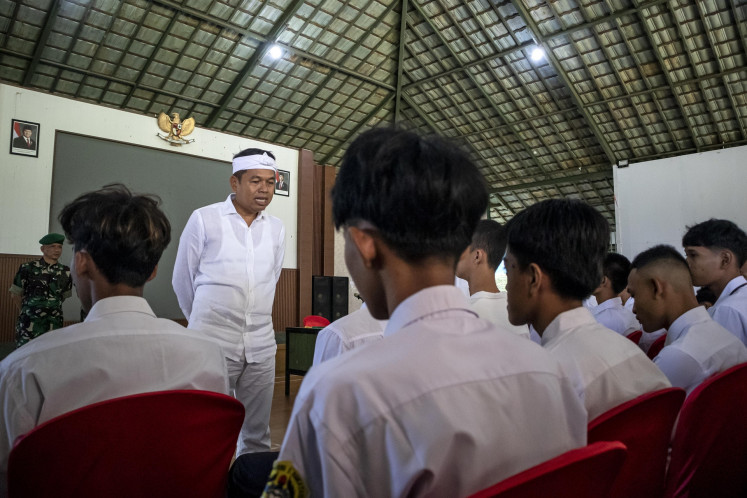'Mahabharata' at the zero point
The Pandu (left) and Kuru families (right) battle over diceA gong strikes and the theater darkens
Change text size
Gift Premium Articles
to Anyone

The Pandu (left) and Kuru families (right) battle over dice
A gong strikes and the theater darkens. As the music slowly builds, performers clad in white begin circling the stage. One dances like a ballerina. Another dons a shiny blue long coat and begins to tell the tale of the Mahabharata.
The kinetic performance, titled Theater Mahabharata and staged by Salihara late last month, was the brainchild of Japanese artist, Hiroshi Koike, who returned to the South Jakarta arts space for a two-show run of his adaptation of the famed Indian epic.

Dialogue was reduced with every rewrite in favor of movement, taking advantage of the skills of the performers, who came from several Asian nations, including India, Indonesia, Japan, Malayasia and Thailand.
Tetsuya Koyano from Japan, for example, is a contemporary dancer, while Chumvan Sodhachivy from Cambodia specializes in classical Khmer dance and shadow puppetry, which resembles Javanese wayang.
As an example of Koike's focus on movement, take the game of dice between the 'Pandu' and 'Kuru' families that was presented in the performance. Actors wielded oversized dice and struck a variety of poses on opposite sides of the stage to represent victories and losses.


The dynamic choreography reflected Koike's background in martial arts, such as aikido, Greco-Roman wrestling and judo ' he's a black belt. 'From the beginning, I selected space, time and my body [as] the big three elements for the performance,' he said.
While going to high school in the city of Hitachi, Koike, who presented The Restaurant of Many Orders at Salihara in 2013, wanted to become an architect, he said.
However,while at Hitotsubashi University, a friend advised him to try performing arts, which eventually led to work as a television director.
Koike then started the award-winning Pappa Tarahumara performing-arts company in 1982. The 58-year-old has since been part of over 100 productions as director, producer, writer or choreographer.
He traces his interest in the Mahabharata to, among other things, the man-made disaster at the Fukushima Daiichi nuclear power plant that unfolded following the Thoku earthquake and tsunami in 2011.
'At that time, almost all Japanese thought 'We must change,'' says Koike.
He dissolved Pappa Tarahumara, then around 30 years old, to start again. 'I want to stand on the zero point,' Koike said. 'I dissolved my company and nothing was standing.'
He spent a year before launching his next endeavor, the multimedia Bridge Project, to connect the world, time and culture, according to its website.

'I made the Bridge Project, meaning there are many kinds of layers. I want to make a bridge,' says Koike.
His staging of the Mahabharata reflects that philosophy, according to the artist. 'What is human? What is our purpose to live?' Koike says. 'In the Mahabharata, there are many kinds of layers.'
The version of the Mahabharata presented at Salihara is the second chapter of an adaptation that Koike began in 2013. Performers of the Bridge Project also presented it in Mumbai, India, and Kuala Lumpur, Malaysia.
'I want to ask everybody to feel harmony,' Koike says. 'Maybe in 10 years [or] 100 years, we'll face the big crises. We need this kind of harmony.'

Photos by JP/Jerry Adiguna
_____________
The writer is an intern at The Jakarta Post









